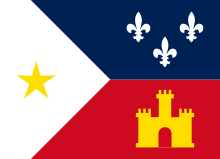Acadiana
Acadiana or Cajun Country is the centuries-old home of the Cajuns , the French- Canadian population in the south of the US state of Louisiana . The main town is Lafayette .
The region
Acadiana stretches from the Texan border along the Gulf of Mexico east to the Mississippi and about 100 miles inland to about Marksville . It comprises the 22 parishes (corresponds to the counties in Louisiana ): Acadia, Evangeline, Iberia, St. Landry, St. Martin, St. Mary, Vermilion, Ascension, Assumption, Avoyelles, Calcasieu, Cameron, Lafayette, Iberville, Jeff Davis, Lafourche, Pointe Coupee, St. Charles, St. James, St. John The Baptist, Terrebonne, and West Baton Rouge, the first eight of which are called Heartland . The flag of the region stands for the cultural and historical origin: three silver lilies on blue for France , a gold castle on red for Castile , a gold star on white for the Virgin Mary .
history
The ancestors of the Cajuns come from the former French colony of Acadia . From there they were brutally expelled by the British in 1755 after their final victory in the so-called French and Indian War . Acadiana is the Latin adjective for Acadia ; Cajun is a corruption of the English pronunciation of the French Acadiens .
Many survivors settled after years of wandering in Louisiana, which although in 1763 by France to Spain ceded was, however, had kept the French governor and was glad of any immigration. Napoléon Bonaparte bought the territory back in 1800 and sold it again in 1803 in the largest real estate deal in world history to the USA, of which the Cajuns have been citizens since then.
Language and culture
Until the beginning of the 20th century , the Cajuns lived largely self-sufficient from American influences and retained their culture (which should not be confused with that of the melting pot New Orleans ). Among other things, their music , their peculiar old dialect and their well-known cuisine should be mentioned.
It was only in the 1930s, when oil was found in their area, that the Cajuns came into contact with the Americans and were urged to Anglicize . Children who spoke Cajun in school were defamed and despised by the new immigrants because of their faulty English, and from 1915 they could even be punished for it. In 1921 the use of French in public schools was banned by law. It wasn't until the late 1960s that the Cajuns managed to gain recognition for their culture. Since 1968, a government organization, the Council for the Development of French in Louisiana (CODOFIL), has been committed to protecting their culture.
According to the results of the 1990 census, there were 668,271 Acadiens / Cajuns in the United States at that time, 61% of them in Louisiana.
literature
- Carl A. Brasseaux (text), Philip Gould (photos): Acadiana. Louisiana's historic Cajun country . Louisiana State University Press, Baton Rouge 2011, ISBN 978-0-8071-3723-9 .
- Laura Atran-Fresco: Les Cadiens au présent. Revendications d'une francophonie en Amérique du Nord. Les Presses de l'Université Laval, Québec 2016
- Review by Hans-Jürgen Lüsebrink, 2018
Footnotes
- ↑ Shane K. Bernard: The Cajuns. Americanization of a People . University Press of Mississippi, Jackson 2003, p. 5.
- ↑ a b L'Histoire du français en Louisiane , accessed on October 1, 2016.
- ↑ James H. Dorman: Louisiana's Cajuns. A Case Study in Ethnic Group Revitalization . In: Social Science Quarterly , Vol. 65 (1984), No. 4, pp. 1043-1057.
- ↑ Le CODOFIL in le mouvement francophone en Louisiane . In: Présence Francophone , vol. 43 (1993), pp. 27-28.

